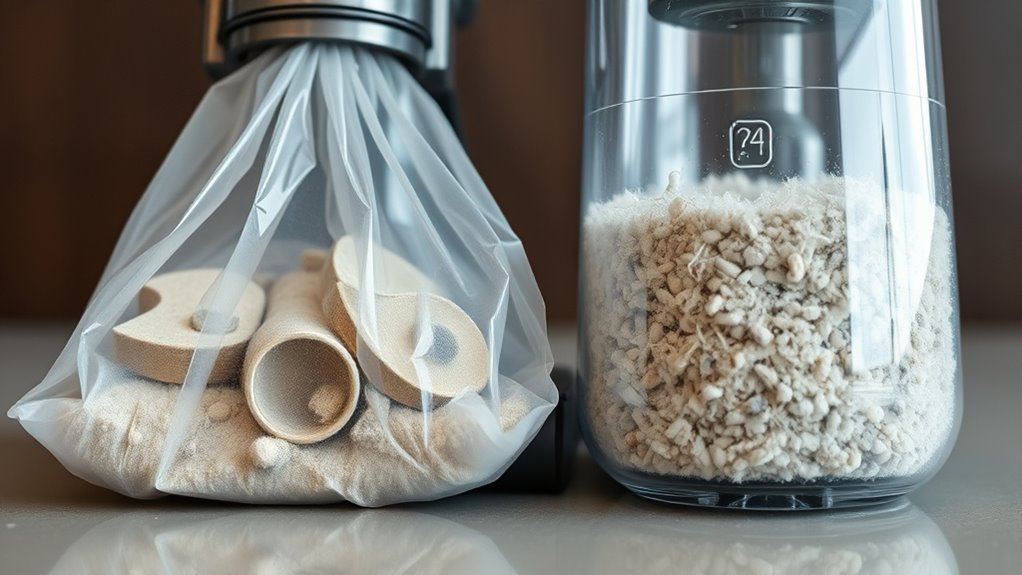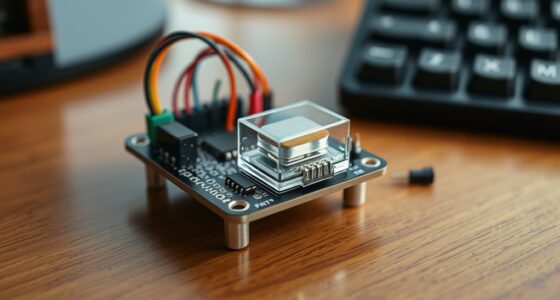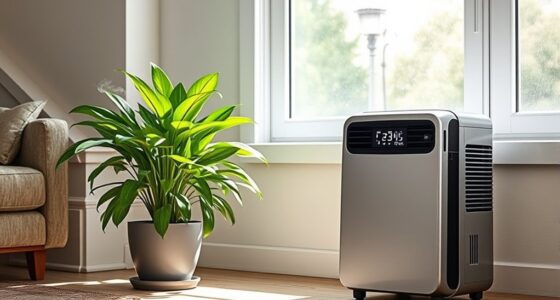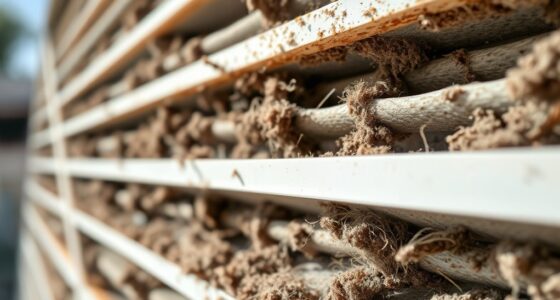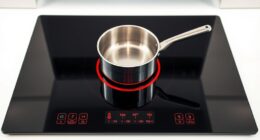If you’re concerned about allergens, a bagged vacuum is usually the better choice. Its sealed bags and HEPA filters trap tiny particles and prevent dust from escaping during cleaning and disposal. Bagless models can release allergens if not handled carefully, especially when emptying the canister. Overall, bagged vacuums offer more effective allergen containment with less maintenance hassle. Want to discover which model fits your needs best? Keep exploring for more insights.
Key Takeaways
- Bagged vacuums with HEPA filters and sealed bags provide superior allergen containment during both use and disposal.
- Bagless models may have HEPA filters but often risk releasing allergens if the canister isn’t sealed properly.
- Replacing bags is less messy and minimizes allergen exposure compared to emptying a canister in bagless vacuums.
- Proper disposal of bagged units keeps allergens contained, reducing airborne allergen release.
- Overall, bagged vacuums generally offer better allergen trapping and containment for allergy sufferers.
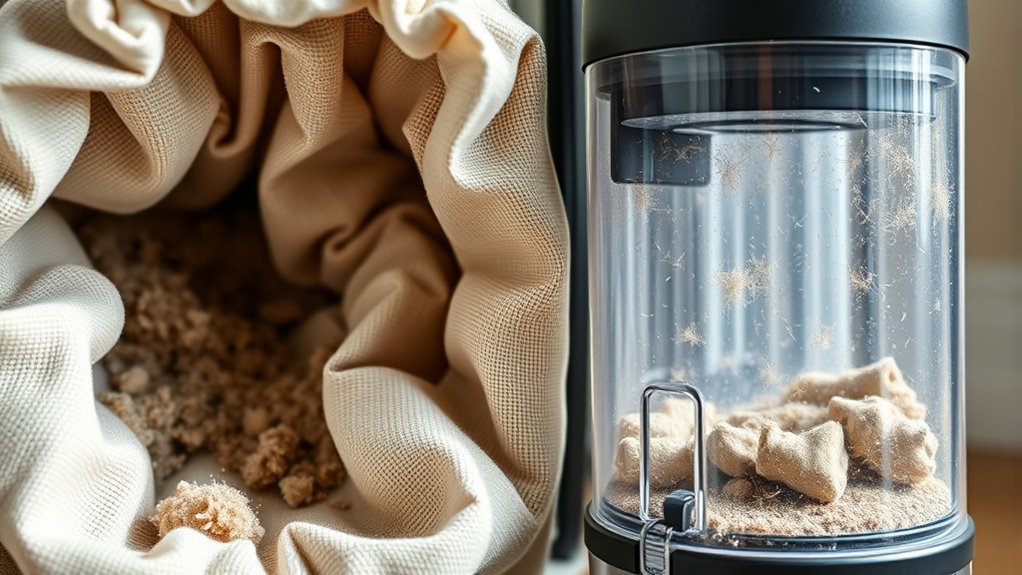
When choosing a vacuum cleaner, you’ll often hear about the differences between bagged and bagless models. One key factor to _take into account_ is how each type handles allergens and how easy they are to maintain. Bagged vacuums typically use HEPA filtration options, which trap tiny particles like dust mites, pollen, and pet dander more effectively than many bagless models. If you or your family members suffer from allergies or asthma, a bagged vacuum with HEPA filters can make a noticeable difference in indoor air quality. The sealed design of bagged units ensures that allergens stay contained inside the bag, reducing the risk of them escaping back into the air once you empty or replace the bag. This containment can be especially beneficial for sensitive individuals, as it minimizes exposure during cleanup.
In contrast, bagless vacuums often rely on transparent canisters that you empty frequently. While this might seem convenient, it can lead to some allergens escaping into the air during disposal if the canister isn’t sealed properly. However, many modern bagless models now incorporate HEPA filters or advanced filtration systems to improve allergen trapping. Still, the ease of maintenance is a point where bagged vacuums usually have the upper hand. With a bagged vacuum, you simply replace the bag when it’s full—no need to clean or empty a canister, which can be messy and expose you to dust and allergens. This process is straightforward and less time-consuming, making bagged models particularly appealing for those prioritizing low-maintenance cleaning routines.
On the other hand, bagless vacuums require you to regularly empty and clean the canister, which can be a hassle, especially if you’re sensitive to dust. Some newer models feature washable filters, which can be reused after cleaning, but this adds steps to your maintenance routine. If you prefer a vacuum that minimizes ongoing upkeep, a bagged model with HEPA filtration generally offers a simpler, cleaner solution. Plus, because the bags are designed to contain allergens securely, you’re less likely to experience the dust cloud that sometimes occurs when emptying a canister.
Frequently Asked Questions
How Often Should I Replace Vacuum Bags or Filters?
You should replace vacuum bags and filters based on their recommended replacement frequency, usually after every 1-3 months, or when they become visibly full or clogged. Regular filter maintenance ensures peak performance and better allergen trapping. Check your vacuum’s manual for specific guidelines, and don’t forget to replace or clean filters and bags promptly to maintain air quality and prevent allergens from lingering in your home.
Are Bagless Vacuums More Hygienic Than Bagged Models?
You might wonder if bagless vacuums are truly more hygienic. The answer depends on filtration efficiency and dust compartments. Bagless models often have powerful filters that trap allergens effectively, but their dust compartments need regular cleaning to prevent mold and bacteria growth. If you maintain them well, bagless vacuums can be hygienic, but neglecting cleaning tasks might make bagged models more reliable for allergen control.
Can Vacuum Type Impact Asthma or Allergy Symptoms?
Your vacuum type can definitely impact asthma or allergy symptoms. If you choose a model with HEPA filtration, it traps more allergens and improves air quality, which helps reduce symptoms. Bagged vacuums often contain allergens better, preventing them from escaping back into your environment. Bagless models with HEPA filters can also be effective, but make sure to empty the canister carefully to avoid releasing trapped allergens.
What Is the Cost Difference Over the Vacuum’s Lifespan?
When considering the cost difference over your vacuum’s lifespan, you’ll find that bagless models often have lower long-term savings due to no replacement costs for bags. However, you might face higher replacement costs for filters and parts. Bagged vacuums tend to have higher initial costs but lower replacement expenses. Think about your maintenance preferences and budget to decide which option offers better long-term savings for you.
Do Vacuum Bags or Bagless Models Require More Maintenance?
You’ll find that vacuum bags generally need less maintenance, as you just replace the bag and occasionally check the filter. Bagless models require more frequent filter replacements and dust disposal, since you empty the canister often. This means more regular upkeep, but it also lets you see when it’s full. Overall, bags mean less daily maintenance, while bagless models demand more attention to filter replacement and dust disposal.
Conclusion
So, whether you choose a vacuum bag or bagless model, it’s funny how the right choice can unexpectedly improve your allergy symptoms. You might find that switching to a bagless design, with its HEPA filters, traps allergens better than you thought. Or maybe sticking with a traditional bag keeps dust contained just as well. Either way, it’s a coincidence how small details in your vacuum can make a big difference in your home’s air quality—and your comfort.
